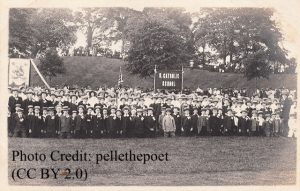
Sandwiched between the twin horrors of World War I and the Great Depression, the “roaring twenties” are often seen as a light-hearted and carefree time.
However, great social forces were bubbling under the surface, especially in the field of public education. Inside of the Church and academia, traditionalists and modernists had been jousting intellectually for years. Many claimed that the State had the exclusive right to educate children.
The Little Girl Satanist Next Door
Popular Sentiment Against Catholic Schools
In 1920, U.S. public elementary school enrollment was 19.3 million.1 Catholic schools had an enrollment of 1.7 million students.2 To modern eyes, the idea that Catholic schools threatened the nation appears laughable. However, many elements in American society held this view.
Part of this attitude stemmed from World War I. Many immigrants from southern Germany and Austria tended to place their children in German-speaking Catholic schools. When the U.S. entered World War I in 1917, many considered these Catholic “enemy aliens” and their children as security risks.
Poles, Italians, and numerous others also had Catholic schools where their native languages were spoken. When the Bolsheviks took over Russia, many suspected immigrants might be infiltrated by socialists. “If they have nothing to hide,” an erroneous but common sentiment held, “why don’t they speak English?”
10 Steps to Prepare for America’s Economic Collapse
The Passage of the Oregon Law
In fact, many groups and organization got involved in an Oregon law that challenged Catholic education.3
One influential group that heavily supported the idea was the Ku Klux Klan. Having expanded their base nationwide, they saw Catholics as a threat to American institutions. The spiritual leadership of the Pope in Rome did not fit with their brand of one-hundred-per-cent Americanism.
In 1922, Oregon voters passed a Compulsory Education Act by a fifty-three percent margin. Its main provision was a rule:
PETITION: Arkansas Keep 10 Commandments. Stop Satanists!
Requiring any parent, guardian or other person having control, charge or custody of a child over eight and under sixteen years of age, from and after September 1, 1926, to send such child to a public school during the entire school year.
There were exceptions, but parochial schools were not among them. The penalty was a fine of five to one hundred dollars and/or imprisonment from two to thirty days.4
A Victory of the Church over the State
Catholics reacted with alarm. Archbishop Austin Dowling of Saint Paul, Minn. compared the law to the “Soviet claim to invade the home and substitute communal for parental care.” Archbishop Michael Curley of Baltimore echoed a similar concern, “The whole trend of such legislation is state socialism.5”
A number of liberal organizations – among them The New York Times, The Chicago Tribune, The Atlantic Monthly, and the American Civil Liberties Union took the Church’s side. Even John Dewey, the most prominent proponent of progressive education of the time, supported the Catholic position.6
The Society of the Sisters of the Holy Names of Jesus and Mary brought suit. The Oregon District Court issued an injunction restraining the State. The State appealed the case to the U.S. Supreme Court.
The Supreme Court unanimously ruled in favor of the Sisters in a decision that could hardly have been more sweeping:
The child is not the mere creature of the State; those who nurture him and direct his destiny have the right, coupled with the high duty, to recognize and prepare him for additional obligations.
Choosing between the power of the State and the family, the court came down firmly on the side of the family.
Would the Same Thing Happen Today?
It is interesting to speculate about how that case would come out today. While Catholic schools still exist, they are heavily state regulated. Their role is in Catholic life has diminished since some believe that forty-five minutes a week in CCD is equivalent to daily religion classes. In 1920, there were 1.7 million students in Catholic elementary schools. Today, there are 1.2 million students, even though the population of the U.S. has tripled.
If the modern Church were attacked in this way, it would not have the same allies. Today, the liberal media are more likely to indict Holy Mother Church than to spring to Her defense.
Nor is it certain that the Supreme Court would uphold the Church’s position. The Court once prided itself as being an impartial arbiter of the law as written and defined over centuries. Now its members determine what they think the law should be and make it so, usually to increase State power.
A century ago, the Catholic school was the backbone of the Catholic parish. Apart from administering the Sacraments, it was the most important ministry of a parish. Today’s Catholic parish is all too likely to see closing the school as a necessary economy, rather than a desperate measure to be taken only if the survival of the parish itself is imperiled.
[like url=https://www.facebook.com/ReturnToOrder.org]
The order that brought the suit, The Society of the Holy Names of Jesus and Mary, has also deteriorated. According to the 1910 Catholic Encyclopedia, they operated forty-eight schools in the U.S. Today, the order’s website lists seven. Only one of their schools is in Oregon.
Apparently, many modern Catholics are quite willing to let the child become the mere creature of the State.
1. https://nces.ed.gov/pubs93/93442.pdf, 34.
2. https://www.internationalstudent.com/student-news/articles/catholic-schools-usa/
3. Lloyd P. Jorgenson, “The Oregon School Law of 1922: Passage and Sequel”, The Catholic Historical Review, 54:3 (October 1968), 467.
4. David B. Tyack, “The Perils of Pluralism: The Background of the Pierce Case,” The American Historical Review, 74:1 (October 1968), 76.
5. Jorgenson, 458-459.
6. Quoted in Jorgenson, 460-461


